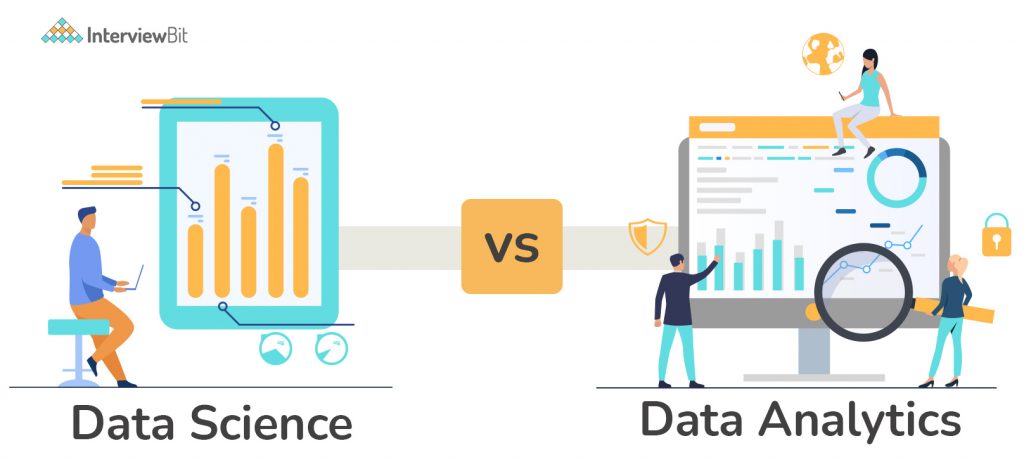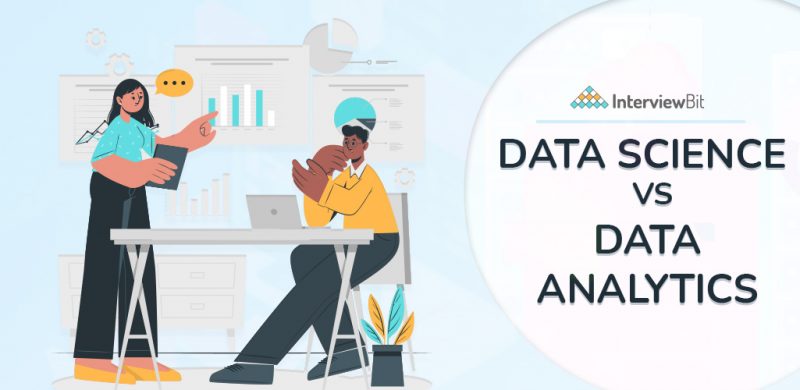With the rise of Big Data, two new buzzwords in the industry have emerged: Data Science and Data Analytics. The entire world now contributes to tremendous data expansion in colossal proportions, thus the term “Big Data.” According to the World Economic Forum, everyday global data creation will exceed 44 zettabytes by the end of 2020. By 2025, this figure will have risen to 463 exabytes!
Big Data encompasses everything we do online, including messages, emails, tweets, user queries (on search engines), social network activity, and data created by IoT and connected devices. Traditional data processing and analysis tools can’t handle the massive amounts of data generated every day by the digital world.
We commonly use Data Science and Data Analytics interchangeably since Big Data, Data Science, and Data Analytics are still developing technologies. The fact that both Data Scientists and Data Analysts work with Big Data (large and complex datasets having large variety, volume, and velocity) contributes to the misconception. Despite this, the distinction between Data Analysts and Data scientists is apparent, fueling the dispute between Data Science and Data Analytics.
Confused about your next job?
- What is Data Analytics?
- Primary Types of Data Analytics
- Features of Data Analytics
- What is Data Science?
- Features of Data Science
- Data Analytics Vs Data Science
- Data Analysts Responsibilities
- Data Scientist Responsibilities
- Data Analyst Skills
- Data Scientist Skills
- Data Analyst Salary
- Data Scientist Salary
- Conclusion – Which career is right for you?
- Frequently Asked Questions
- Q1. Can a data analyst become a data scientist?
- Q2. Is Data Analyst a good career?
- Q.3: Which job has a higher salary: Data Analyst role or Data Scientist role?
- Q.4: What is the eligibility for Data Analysts?
- Q.5: Do Data Analysts need to be good at Math?
- Q.6: Is Data Analytics hard to learn?
- Additional Resources
What is Data Analytics?

The term “data analytics” refers to the act of analyzing datasets (collection of values that relates to a particular subject) in order to derive conclusions about the information contained within them. Data analytic techniques allow you to take raw data and derive important insights from it by uncovering patterns. These patterns might be useful in improving the sales of a business by making better recommendations to a user.

Many data analytics techniques nowadays rely on specialized systems and software that combine machine learning algorithms, automation, and other features. In research, data analysts apply data analytics methodologies, and businesses use them to guide their judgments. Data analysis may assist businesses in better understanding their clients, evaluating their advertising efforts, personalizing content, developing content strategies, and developing new products. Finally, firms may employ data analytics to improve their bottom line and boost their performance.
Primary Types of Data Analytics

1.Descriptive Analytics – Descriptive analytics aids in the investigation of events. To describe outcomes to stakeholders, these strategies synthesize big datasets. These tactics can help track successes and failures by establishing key performance indicators (KPIs). In many businesses, metrics like return on investment (ROI) or others are used. To track success in certain industries, specialized metrics are devised. This procedure necessitates the gathering of relevant data, data processing, data analysis, and data visualization. This procedure provides crucial information about previous performance.
2. Diagnostic Analytics – Diagnostic analytics can assist you to figure out why things transpired the way they did. These strategies are used in conjunction with more basic descriptive analytics. They take the results of descriptive analytics and delve further to discover the root of the problem. The performance indicators are looked at further to see why they have improved or deteriorated. This usually happens in three stages:
- Recognize any discrepancies in the data. These could be unanticipated changes in a statistic or a market.
- Data pertaining to these anomalies is gathered.
- To uncover links and trends that explain these abnormalities, statistical approaches are applied.
3. Predictive Analytics – Predictive analytics aids in determining what will occur in the future. These methods make use of historical data to uncover patterns and decide if they are likely to repeat again. Predictive analytical tools use a number of statistical and machine learning approaches, such as neural networks, decision trees, and regression, to provide significant insight into what might happen in the future. This might be used by stock consulting agencies to analyze the trends in which the prices of the stocks have crashed in the past and to advise their customers properly.
4. Prescriptive Analytics – Prescriptive analytics assists in determining what should be done. Data-driven decisions can be made utilizing predictive analytics insights. In the face of uncertainty, this enables firms to make educated judgments. Machine learning strategies are used in predictive analytics techniques to detect trends in massive datasets. The chance of various outcomes can be determined by evaluating past decisions and events.
Features of Data Analytics
1.Better Decision-Making – Companies may employ data analytics insights to better guide their decisions, resulting in improved outcomes. Data analytics takes out a lot of the guesswork in marketing campaigns, content creation, product development, and other areas. It provides you with a 360-degree perspective of your customers, allowing you to better understand them and address their demands. Furthermore, contemporary data analytics technology allows you to collect and analyze fresh data on a constant basis to keep your understanding up to date as conditions change.
2. Increased Marketing Efficiency – You can market to your audience more successfully if you have a deeper understanding of who they are. Data analytics can also help you understand how well your campaigns are functioning so you can fine-tune them for the best results.
You may learn which audience groups are most likely to connect with a campaign and convert with the Lotame Campaign Analytics tool. You can utilize this data to manually or automatically alter your targeting criteria or to build different messaging and creative for different categories. More conversions and less ad waste result from better targeting.
3. Operational Efficiency – Data analytics can assist you in streamlining your procedures, saving money, and increasing your profits. You waste less time developing advertising and content that don’t fit your audience’s interests when you have a better understanding of what they want.
This means you’ll spend less money and get better outcomes from your campaigns and content strategy. Analytics can generate revenue through increasing conversions, ad revenue, or subscriptions in addition to lowering costs.
4. Customer Service Improvements – Data analytics can help you gain a better understanding of your consumers, allowing you to adjust customer care to their specific needs, provide greater personalization, and strengthen customer connections.
Your data may provide details about your consumers’ communication preferences, interests, and worries, among other things. Having a common repository for this information means that your whole customer service staff, as well as your sales and marketing departments, are on the same page.
It can also be used to detect the category of things that a particular user buys or sees and to recommend related products to them, thereby improving the business.
What is Data Science?

Data science is an interdisciplinary approach to obtaining useful insights from today’s organizations’ massive and ever-increasing volumes of data. Preparing data for analysis and processing, undertaking advanced data analysis, and presenting the results to expose trends and allow stakeholders to make educated decisions are all part of data science. Data Science, in its broadest sense, is the study of data, including what is its source, what it represents, and how it may be turned into useful inputs and resources for business and IT strategy.
There are five major stages in the life cycle of a Data Science project. They are as follows:
- Gathering Data – The first stage in every data science endeavour is fairly straightforward: gather and receive the data you require. You won’t be able to process anything if you don’t have any data, to begin with.
- Scrubbing Data – The most important part of the data scrubbing procedure is for us to “clean” and filter the data. Remember the “garbage in, garbage out” principle, which states that if the data used is unfiltered and irrelevant, the analysis results will be meaningless. You must convert data from one format to another and combine everything into a single standardized format for all data in this procedure. If your data is stored as CSV files, for example, you’ll need to run SQL queries on it in order to use it with computer languages like Python or R.
- Exploring Data – You’ll need to investigate the data once it’s ready to be used, and before you dive into AI and Machine Learning. In a corporate or business setting, your supervisors would usually just toss you a bunch of data and leave it up to you to figure out what to do with it. As a result, it will be up to you to assist them in determining the business question and converting it into a data science query. Various algorithms and marketing strategies can be used to find something useful from the data.
- Modelling Data – This is the most fascinating phase of a data science project’s lifecycle. It’s “where the magic happens,” as many people would put it. One of the first steps in data modelling is to limit the number of dimensions in your data set. Not all of your features or values are required for your model to be predicted. As a result, you must select the relevant ones that will contribute to the forecast of the desired results.
- Interpreting Data – Interpreting data simply means presenting your data and delivering the outcomes in a way that answers the business questions you posed when you first started the project, as well as the actionable insights gained through data science.
Features of Data Science

Following are the main features of Data Science
- Understanding of the Business – Even if you know a lot about machine learning algorithms and have solid statistical skills, you won’t be able to construct a good model unless you understand the company. A data scientist must first comprehend the business demand before developing analytics to meet it. As a result, business domain knowledge becomes vital or useful.
- Intuition – Despite the fact that arithmetic is sound and foundational, a data scientist must choose the proper model with the right precision, as not all models produce the same results. As a result, a data scientist must be able to tell when a model is ready to be deployed in production. They also require insight to recognize when a production model has become stale and requires restructuring in order to adjust to changing business conditions.
- Curiosity – Data science isn’t a brand-new discipline. It has existed in the past as well, but growth in this subject is extremely rapid. As new approaches to handling well-known problems emerge on a regular basis, a data scientist’s desire to learn about emerging technology becomes increasingly vital.
Data Analytics Vs Data Science

Data Analysts Responsibilities
Data analysts try to figure out what questions the company needs to answer and then check if they can be answered with data. They must be familiar with the technical aspects of data collection, analysis, and reporting. They must be able to spot patterns and trends. Key data analyst tasks include the following:
- Data analysis and reporting using statistical techniques
- Databases and data collection systems development and implementation
- Obtaining and maintaining data from primary and secondary sources
- Detecting, analyzing, and understanding patterns or trends in large data sets
- Data cleansing and filtering
- Collaborating with business management and developers to identify and prioritize business and information requirements
- Identifying and outlining new opportunities for process improvement
Data Scientist Responsibilities
Following are the responsibilities of a data scientist
- Management – The Data Scientist has a minor managerial position in the Data and Analytics area, where he helps to build a foundation of futuristic and technical talents in order to assist with various planned and ongoing data analytics projects.
- Analytics – The Data Scientist is a scientist who creates, implements, and evaluates high-level statistical models and techniques for use in the company’s most difficult problems. The Data Scientist creates economic and statistical models for a variety of issues, such as projections, classification, clustering, pattern analysis, sampling, simulations, and more.
Strategy/Design: The Data Scientist plays a critical part in the development of creative strategies to better understand and manage the company’s consumer trends and management, as well as approaches to tackle complex business problems such as product fulfilment and overall profit optimization. - Collaboration – The Data Scientist’s position is not a solitary one, and he works with other data scientists to communicate problems and discoveries to key stakeholders in order to improve company performance and decision-making.
- Knowledge – The Data Scientist also takes the lead in experimenting with new technologies and tools in order to develop new data-driven insights for the business at the fastest possible pace. In this case, the Data Scientist takes the initiative in evaluating and implementing new and improved data science methodologies for the company, which he then presents to top management for approval.
- Other responsibilities – A Data Scientist also completes related tasks as directed by the manager.
Data Analyst Skills

The following skills are required for the job role of a data analyst
- SQL – SQL (Structured Query Language) is the industry-standard database language and may be the most crucial skill for data analysts to possess. The language is frequently referred to as a “graduated” version of Excel because it can handle enormous datasets that Excel cannot. Almost every company requires someone who knows SQL, whether it’s to manage and store data, connect different databases ) or develop or update database architecture entirely.
- Analysis Tools like Microsoft Excel – A spreadsheet is probably the first thing that springs to mind when you think of Excel, but it has a lot more analysis capability behind the hood. While a programming language like R or Python is better suited to dealing with huge data sets, advanced Excel approaches such as building macros and employing VBA lookups are still extensively utilized for smaller lifts and quick analytics. If you work for a small business or a startup, the first version of your database can be Excel. The tool has been a cornerstone for firms in every industry over the years, so mastering it is essential.
- Statistical Programming Languages – R or Python can do what Excel does—and 10 times faster. R and Python, like SQL, can manage what Excel can’t. They are statistical programming languages that can be used to do advanced analysis and predictive analytics on large data sets. They’re also both industry-standard. To genuinely work as a data analyst, you’ll need to know at least one of these languages in addition to SQL.
- Critical Thinking and Problem-Solving Skills – To use data to get answers to your questions, you must first figure out what you want to ask, which might be difficult. To be successful as an analyst, you must think like one. A data analyst’s job is to find and synthesize relationships that aren’t always obvious. You must also have good problem-solving skills.
- Data Visualization – It’s critical to be able to tell a compelling tale using data in order to convey your message and keep your audience engaged. You’ll have a hard time getting your message through to others if your findings can’t be simply and immediately recognized. As a result, when it comes to the impact of your data, data visualization may make or break it. Analysts convey their conclusions in a clear and simple manner by using eye-catching, high-quality charts and graphs.
- Machine Learning – Machine learning has been identified as a critical component of an analyst’s toolset, as artificial intelligence and predictive analytics are two of the trendiest subjects in the field of data science. While not every analyst works with machine learning, understanding the tools and ideas is essential for getting far in the profession.
Data Scientist Skills

The following are the skills required for a data scientist
- Maths and Statistics – Any professional Data Scientist will have a strong mathematical and statistical background. Any company, particularly one that is data-driven, will require a Data Scientist to be familiar with various statistical methodologies, such as maximum likelihood estimators, distributors, and statistical tests, in order to assist in making recommendations and judgments. Calculus and linear algebra are both important since machine learning algorithms rely on them.
- Programming – A Data Scientist needs strong programming skills to progress from the theoretical to the creation of real applications. Most employers will want you to be fluent in Python, R, and other programming languages. This category includes object-oriented programming, fundamental syntax and functions, flow control statements, libraries, and documentation.
- Analytics and Modelling – Because data is only as good as the individuals who analyze and model it, a qualified Data Scientist is expected to be well-versed in this domain. A Data Scientist should be able to examine data, run tests, and construct models to collect new insights and forecast future outcomes based on a foundation of both critical thinking and communication.
- Machine Learning – While expert-level understanding in this field isn’t always required, some familiarity will be expected. Machine learning provides crucial features such as decision trees, logistic regression, and more, and future employers will be looking for these talents.
- Data Visualisation – Being a Data Scientist necessitates the ability to effectively communicate critical messaging and gain buy-in for offered solutions, which necessitates the use of data visualization. Understanding how to break down complex data into smaller, more digestible chunks and use a range of visual aids (charts, graphs, and more) is a talent that any Data Scientist will need to master in order to succeed in their profession.
- Problem-Solving Skills – A data scientist should have good problem-solving skills. At any point in development, they must be able to come up with a solution to the problem.
Data Analyst Salary
In India, the average base pay for a data analyst is INR 6,00,000 per year. Top companies that hire for the role of data analyst and their salaries in India are as follows
| Company | Average Salary per year |
|---|---|
| Tata Consultancy Services | Rs 5,00,000 |
| Accenture | Rs 5,64,863 |
| Amazon | Rs 5,37,563 |
| Infosys | Rs 5,48,519 |
| Cognizant | Rs 5,30,000 |
Data Scientist Salary
In India, the average salary for a data scientist is Rs.698,412 per year. Top companies that hire for the role of data scientist and their salaries in India are as follows
| Company | Average Salary per year |
|---|---|
| Accenture | Rs 19,86,586 |
| American Express | Rs 13,50,000 |
| IBM | Rs 14,68,000 |
| Wipro Technologies | Rs 17,50,000 |
| Mc Kinsey and Company | Rs 10,50,000 |
Conclusion – Which career is right for you?
You can begin analyzing which path is the best fit for you once you have a good knowledge of the differences between data analytics and data science, as well as what each career entails.
Three major elements should be considered when determining which path is best aligned with your personal and professional goals.
- Your Personal Background – To assist businesses in making better strategic decisions, data analysts evaluate enormous data sets to discover trends, build charts, and create visual presentations. Analysts often pursue an undergraduate degree in a science, technology, engineering, or math (STEM) discipline, as well as an advanced degree in analytics or a similar subject, to align their education with these jobs. They also want to know if you have any math, scientific, programming, database, modelling, or predictive analytics experience.
Data scientists, on the other hand, are more concerned with developing and implementing new data modelling and production methods. An advanced degree in data science, such as a master’s in data science, is required for professional progress since they use a number of approaches to comb through data, such as data mining and machine learning. - Your interests – Numbers, statistics, and programming are all favourites of data analysts. They nearly solely work in databases as gatekeepers for their organization’s data, uncovering data points from complicated and often diverse sources. Data analysts must also have a thorough awareness of the industry in which they work.
Data scientists must possess a mix of math, statistics, and computer science skills, as well as an interest in — and knowledge of — business. If this description more closely matches your background and experience, a position as a data scientist may be the best fit for you. - Desired Salary and Career Path – The salary of a data scientist in the initial stages of a career is higher than that of a data analyst. If salary is the main motivator for you, you can consider opting for a career in data science. That being said, as one advances in both careers, the salary increases exponentially and so either of the two is a good option, considering in terms of salary.
Frequently Asked Questions
Q1. Can a data analyst become a data scientist?
Ans: There is some overlap between the roles of a data analyst and a data scientist, which may make it easier for a data analyst to advance to the position of a data scientist. Everyone’s journey is unique, but earning appropriate data science skills and continued education are standard steps.
Q2. Is Data Analyst a good career?
Ans: Yes, data analytics is a lucrative profession. Simply put, there has never been a more exciting time to work with data. Every day, 2.5 quintillion bytes of data are created, and the rate is only increasing. As businesses’ data collecting develops in extent and sophistication, it’s natural that they’ll want to make use of it, and Data Analysts are at the forefront of this movement.
Q.3: Which job has a higher salary: Data Analyst role or Data Scientist role?
Ans: In the initial stages of a career, Data Scientists have a higher pay package (which also depends on various factors like location and so on) than Data analysts. However, the salary in both careers increases exponentially as and when one gains experience.
Q.4: What is the eligibility for Data Analysts?
Ans: To work as a data analyst, you must first obtain a Bachelor’s degree in Computer Science or a related field, which is required for the majority of entry-level roles. Finance, Economics, Mathematics, Statistics, and Information Management are all other relevant fields.
Q.5: Do Data Analysts need to be good at Math?
Ans: Because data analysts communicate in numbers, a solid math foundation is a must on the road to becoming a data analyst. A thorough understanding of multivariable calculus and linear algebra, etc will also help you succeed as a data analyst.
Q.6: Is Data Analytics hard to learn?
Ans: Data analysts rely on skills such as R or Python programming, SQL database querying, and statistical analysis. While learning these abilities (and landing a data analyst job) can be difficult, it is entirely feasible with the appropriate mindset and strategy.







 Join WhatsApp Group
Join WhatsApp Group


